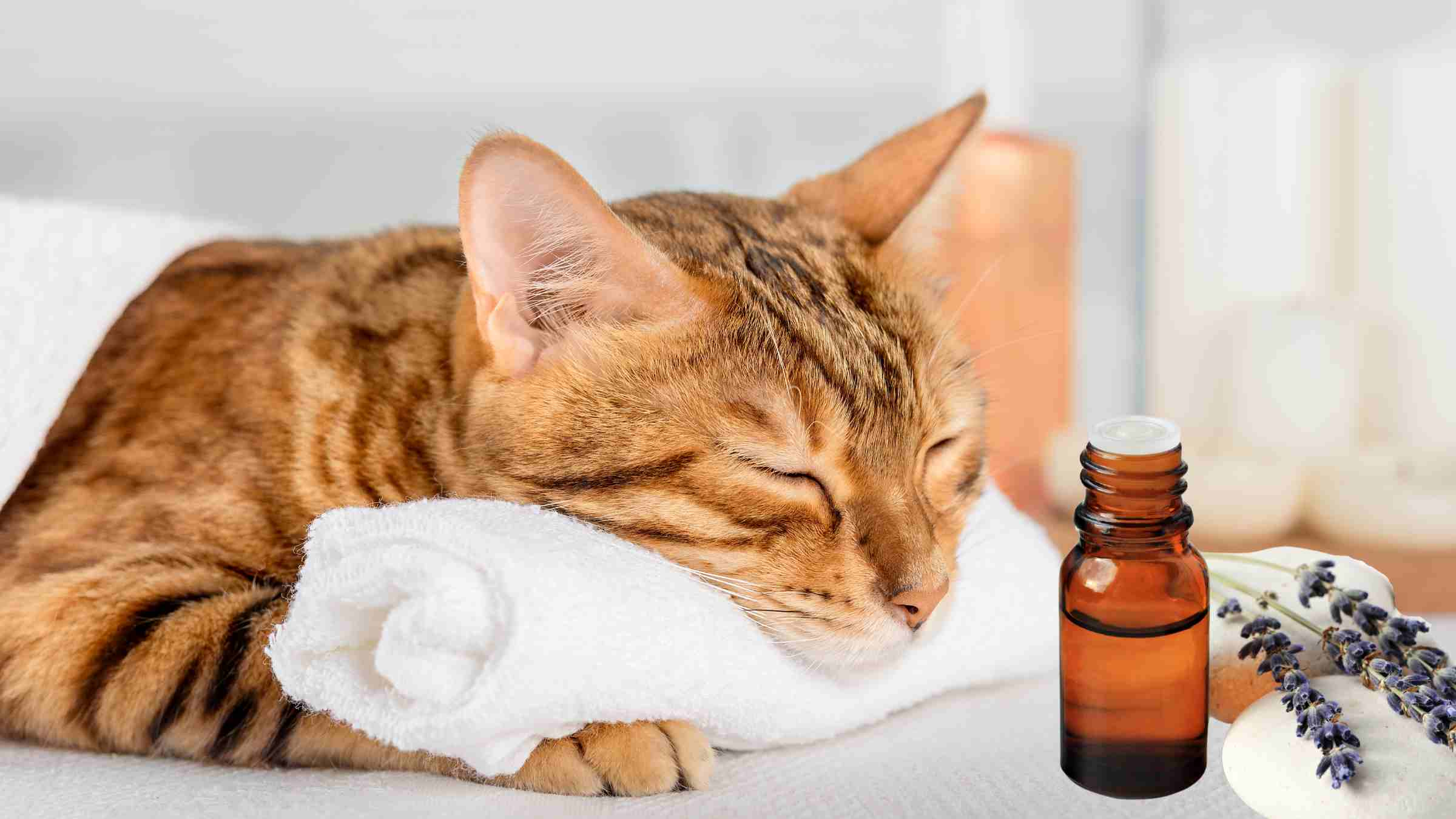🔗 This post contains affiliate links. Read more here.
Does your cat get anxious before vet visits, during thunderstorms, or when guests come over? Many kitties struggle with stress, and as cat parents, we want to help them feel safe and comfortable. Instead of reaching for over-the-counter medications, why not try a gentle, holistic solution?
This DIY Natural Calming Mist is vet-approved and made with cat-safe essential oils that promote relaxation without harsh chemicals. Inspired by the work of Dr. Andrew Jones and Dr. Katie Woodley, this easy spray is perfect for easing anxiety in a natural and effective way.
Prep
- Prep Time: 5 minutes
- Crafting Time: 5 minutes
- Total Time: 10 minutes
Yields
Makes: 300ml
Ingredients & Materials
- 300 ml distilled water
- 3-5 drops lavender essential oil (calming, promotes relaxation)
- 3-5 drops Roman chamomile essential oil (soothes anxiety, reduces tension)
- 3-5 drops copaiba essential oil or catnip essential oil (natural anti-inflammatory, grounding effect)
- 1 glass spray bottle
Optional materials:
- Spray bottle (preferably glass (amber or cobalt blue) to preserve the integrity of the oils)
- Funnel for easy pouring
Instructions
Step 1: Prepare Your Spray Bottle. Use a 300ml glass spray bottle (preferably amber or cobalt blue to preserve the essential oils).
Step 2: Add Distilled Water. Pour 300ml of distilled water into the spray bottle. This ensures the mist is pure and safe for your cat.
Step 3: Add Cat-Safe Essential Oils
- Add 3-5 drops of lavender essential oil (calming effect).
- Add 3-5 drops of Roman chamomile essential oil (soothes anxiety).
- Add 3-5 drops of copaiba or catnip essential oil (natural anti-inflammatory & relaxation boost).
Step 4: Shake Well Before Use. Secure the spray bottle lid and shake well to evenly distribute the oils in the water.
Step 5: Apply the Mist. Lightly spritz your cat’s fur, bedding, or favorite lounging areas about 10 minutes before a stressful event.
Step 6: Observe. While this recipe is designed to be safe for cats, every kitty is unique. Watch for adverse reactions like squinting, watery eyes, or sneezing, rubbing their nose or face excessively, whining, excessive scratching, or acting nervous.
💡Pro Tip: Try misting your hands and gently stroking your cat’s fur instead of spraying directly onto their body.
Why You’ll Love This Recipe
✅ All-Natural & Safe – Free from artificial fragrances, alcohol, and synthetic additives.
✅ Vet-Approved Formula – Inspired by holistic pet care experts, using only feline-friendly essential oils.
✅ Easy to Make – Requires just four simple ingredients and takes under 10 minutes to create.
✅ Helps with Anxiety & Stress – Perfect for travel, fireworks, vet visits, and introducing new pets.
Customization Ideas
- Swap lavender for frankincense if your cat is extra sensitive to floral scents.
- Use catnip essential oil instead of copaiba for a mild euphoria effect (some cats love it!).
- Add a drop of valerian root extract for a stronger calming effect (great for high-stress cats).
Pro Tips for Success
Shelf Life: Up to 3 months if stored properly.
Best Storage Method: Keep in a dark glass spray bottle and store in a cool, dry place away from direct sunlight.
Application:
- Lightly apply on your cat’s fur, bedding, or favorite resting spot.
- Use before stressful situations (vet visits, car rides, parties, thunderstorms).
- Avoid spraying directly on your cat’s face—mist your hands and gently pet them instead.
Safety First
🚫 NEVER use essential oils undiluted on your cat—always dilute in water as directed.
🚫 Do NOT use if your cat has respiratory issues or is prone to asthma.
🚫 Watch for signs of sensitivity– If your cat sneezes excessively, scratches, or avoids the area sprayed, discontinue use.
💡Always ensure you’re using high-quality essential oils. Brands like AnimalEO, Young Living, Mountain Rose Herbs, Plant Therapy, or DoTerra are excellent choices.
Precautions:
Watch for Signs of Sensitivity: While this recipe is designed to be safe for cats, it’s important to remember that every kitty is unique. Keep an eye out for any signs of sensitivity or irritation. If your cat begins squinting, their eyes water, or they start sneezing or rubbing their nose, it might mean the essential oils are too strong for them. Additionally, watch for behavioral signs like whining, excessive scratching, or nervousness. If you notice any of these reactions, stop using the spray immediately and consult your veterinarian.
Dilution is Key to Safety: Proper dilution is critical when using essential oils around cats. A safe topical dilution falls between 0.5% and 1%, equating to roughly one drop of essential oil per 5 ml (1 teaspoon) of an ingestible carrier oil or water. Following the recipe closely ensures the oils remain gentle enough to protect your cat without causing harm. Remember, when it comes to essential oils, less is often more—stick to the recommended amounts for their safety.
Know Where Not to Apply: Essential oils should never be applied to your cat’s sensitive areas, such as their nose, ears, eyes, or genitals, as these spots are highly vulnerable to irritation. Instead, use a flea comb to apply the solution to safer areas like their back, neck, and tail. This approach keeps your cat comfortable while ensuring the repellent is effective in deterring fleas.
Use Extra Caution with Kittens: For cats under 8 weeks old, avoid using essential oils altogether. Kittens’ systems are still developing, making them far more sensitive to even properly diluted solutions. If you’re caring for a young kitten, consider alternative flea prevention methods until they’re older (for example, coconut oil), or consult a holistic veterinarian for safe options.
Pin or Share This Recipe!
Want to save this for later? Pin it to your DIY Cat Care board or share it with a fellow cat parent!
Q&A Section
Q: Can I use this mist daily?
A: Yes! This mist is gentle enough for daily use. However, always observe your cat’s response and adjust as needed.
Q: What if my cat doesn’t like sprays?
A: If your cat is sensitive, spray the mist onto your hands and gently pet them instead.
Q: Can I use this mist on kittens?
A: This is not recommended for kittens under 12 weeks old, as their bodies are more sensitive to essential oils.
Q: Can I use different essential oils?
A: Only use cat-safe essential oils! Some essential oils, like tea tree and citrus oils, are toxic to cats. Always research before substituting.
Looking for more DIY Recipes?
- DIY Natural Flea Repellent
- DIY Cat-Safe Healing Salve for Dry, Itchy Skin
- Holiday-Inspired Kitty Cocktail
- DIY Herb Garden For Cats
Disclaimer
The information provided in this blog post is for educational purposes only and should not be considered medical advice. It is not intended to replace consultation with a qualified holistic veterinarian or professional feline specialist. Every cat is unique, and individual circumstances may vary. We recommend consulting with a licensed veterinarian before making any changes to your cat's diet, lifestyle, or healthcare regimen. Additionally, we encourage readers to conduct their own research and consider multiple sources of information before making any decisions regarding their cat's health.





